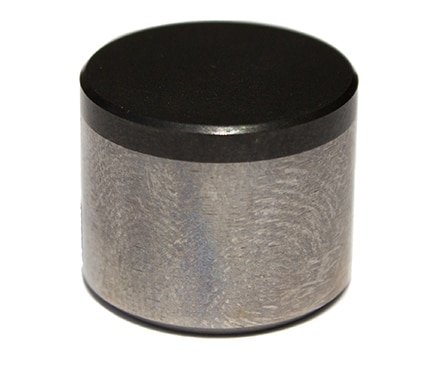PDC Cutters
The invention of the PDC cutter propelled the fixed cutter to the forefront of the drilling industry and the idea instantly took off. Because the shearing action of PDC cutters are more efficient than the crushing action of a button or tooth bit, fixed cutters are in high demand.
In 1982, PDC drill bits accounted for only 2% of total footage drilled. In 2010, 65% of total footage drilled was by PDCs.
Applications
The diamond drill bit is used in nearly all applications including geothermal energy drilling, mining, water well and natural gas drilling and oil well drilling. Total depths range from 100′ to 20,000′.
PDC drill bits are used extensively in natural gas drilling.
Limitations
Impact damage, heat damage and abrasive wear all inhibit a drill bit’s performance and can occur in even the softest geological formations. However, the most difficult formation for a PDC bit to drill are extremely abrasive ones.
With PDC popularity on the rise, bit manufacturing companies are seeking new materials and design aspects to make a tougher bit without compromising ROP.
How PDC Cutters are made
Cutters are made using a combination of high heat and high pressure. Man made diamonds can be grown in 5-10 minutes. Because of this diamond content, a fixed cutter bit may also be known as a diamond drill bit.
High heat plus pressure creates a PDC (polycrystalline diamond compact) cutter.
Cutters are made from a carbide substrate and diamond grit. High heatof around 2800 degrees and high pressure of approximately 1,000,000 psi forms the compact. A cobalt alloy is also present and acts as a catalyst to the sintering process. The cobalt helps bond the carbide and diamond.
During the cooling process, the tungsten carbide shrinks at a rate of 2.5 times faster than the diamond. Controlling this stress, as with most aspects of drill bit design, is called Intellectual Property, and manufacturers rarely, if ever, share their secrets.
Large vs. Small Cutters
As a general rule, large cutters (19mm to 25mm) are more aggressive than small cutters. However, they may increase torque fluctuations. Additionally, if the BHA has not been designed to handle the increased aggressiveness, instability may result.
Smaller cutters (8mm, 10mm, 13mm and 16mm) have been shown to drill at higher ROP than large cutters in certain applications. One such application is limestone.
Also, bits designed with smaller cutters but more of them can withstand higher impact loading.
Additionally, small cutters produce smaller cuttings while large cutters produce larger cuttings. Large cuttings may cause problems with hole cleaning if the drilling fluid cannot carry the cuttings up the annulus.
| Mining/Geothermal/Shallow Oil and Gas | ||
| Cutter Size | Diameter | Height |
| 0804 | 8.20 mm | 4.50 mm |
| 0808 | 8.20 mm | 8.00 mm |
| 1004 | 10.00 mm | 4.50 mm |
| 1304 | 13.30 mm | 4.50 mm |
| 1303 | 13.30 mm | 3.53 mm |
| 1308 | 13.44 mm | 8.00 mm |
| Oilfield Drilling Bits | ||
| Cutter Size | Diameter | Height |
| 1308 | 13.44 mm | 8.00 mm |
| 1313 | 13.44 mm | 13.20 mm |
| 1608 | 16.00 mm | 8.00 mm |
| 1613 | 16.00 mm | 13.20 mm |
| 1908 | 19.05 mm | 8.00 mm |
| 1913 | 19.05 mm | 13.20 mm |
| 1916 | 19.05 mm | 16.00 mm |




